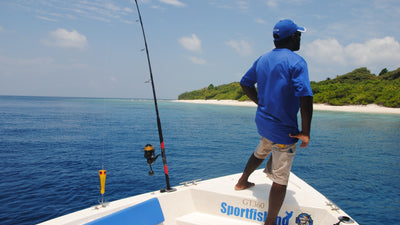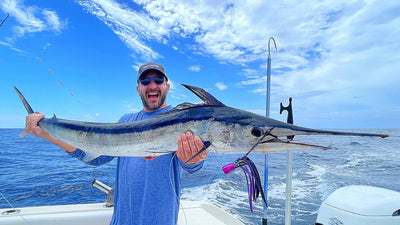When we imagine a catch, depending on the prey and the type of fishing, we will be attracted by a particular factor, whether it is the moment of the strike with the clutch starting like a rocket in high seas or drifting, or the attack in top water when spinning, as well as the strike to a violent attack when jigging, and so on... But all the techniques have something in common, that almost sacred moment, in which we will free the prey from the threat of the hook, which will necessarily mark the end of the fight.

One afternoon, while walking with my 6-year-old son on the seafront of my city, my attention fell on a fisherman in the distance engaged in a fight with a fixed rod. From the curve of the rod, the fish seemed to be interesting, so I began to point out the event to my son, to arouse his curiosity, pointing out the bent fishing rod. I approached convinced that the game would be over by then with the fish already in the bucket, but the fight did not seem to end ... so I realized that the fisherman, a very elderly man, was having difficulty managing the situation. When I got close to him, I saw that with his right hand he was holding the rod to keep the fish afloat, and with his left he was holding a long landing net that he was unable to lift to direct it towards the prey. I offered to help him with the landing net, but he kindly asked me to hold the rod for him ... he wanted to land the fish himself. So I did, and I helped him carry his prey to the bag, a truly generously sized bream. I began to show the physical characteristics and livery to my son, explaining some curiosities about the behavior of salemas, and I noticed that the old fisherman was once again in difficulty, this time in the unhooking phase. Thinking that we were now friends, I offered to help him again by taking my Leatherman pliers that I always carry with me from my pocket. This time, however, the answer was no: that moment was all for him and he had to succeed alone. He was there, proud, handling his prey with religious concentration, enjoying the last moments before putting it aside.
And after all, it doesn't matter the size of the prey, or whether you caught it with equipment costing thousands of euros or with a fixed rod, you want to enjoy every moment of that fight, especially those moments when you are so close and the fish is still, that you can perfectly observe its physical characteristics, which will remain forever imprinted in your memory.

Pictured is an imperial needlefish caught with a Jet Monkey .
Each with its own character
This time we are not talking about the character of the old fisherman, but that of the fish. Not all species, in fact, behave in the same way, both during the fight and in the final stages.
Let's take for example a tuna and a dentex: while the first one, once hoisted on board, seems more like a crazy machine gun than a fish, the second one, apart from a few bursts of vitality every now and then, will remain mostly still, thus giving the possibility to "operate" calmly. Clearly the discussion widens even more, involving other species, such as beaked fish, serranids such as sea bass and grouper, or other pelagic fish such as dolphin fish, passing through sharks. Each of these fish has its own way of behaving, which therefore also implies a completely different approach on our part to be able to unhook them in complete safety for us and for the fish, in the event that we wanted to carry out the C&R.
With tuna, in fact, the idea of hoisting them on board to unhook them in the cockpit is almost unthinkable, if our intention is to release them: they would risk easily injuring themselves by struggling with a certain intensity. Much better then to leave the fish in the water, giving up a photo in your hands, and unhook it directly overboard. With billfish, on the other hand, which receive the greatest trauma precisely when they are grabbed by the rostrum, shaking their head before calming down, you could even risk trying to hoist them on board for a souvenir photo... but if we really want to be certain of their survival, it will be preferable to unhook them in the water without grabbing them by the rostrum. Serranids, as well as sparids and other predators of the coastal area and beyond, once they come within close range of the fisherman have a fairly calm reaction, leaving ample space for unhooking maneuvers, while paying attention to those peaks of energy in which the fish struggles for a few seconds, enough to hurt us with a hook or a thorn.

In the photo a catch with the Albacore Tube .
Aid for fishermen
Taking for granted that you should never try to unhook a fish with your bare hands, we can use numerous tools to support the fisherman in those last delicate phases. It may seem obvious, but a simple pair of pliers with a long, thin beak can be extremely important and fundamental in being able to extract a hook from the mouth of any fish, avoiding the risk of bites or stings from other possible hooks. Another very important and trusty companion is the boga grip : there are many sizes, depending on the prey itself, but in all cases it helps to keep the fish still, holding it by the jaw, so as to be able to operate freely always with the aid of the aforementioned pliers to extract the embedded hooks. The same boga grip will also be useful in the phases of oxygenation of the fish for a possible release. A good pair of gloves , on the other hand, will be essential in grabbing the rostrati by the sword and holding them as firmly as possible during the classic initial outburst. Once calmed down, it will always be our concern to free them from the hook as soon as possible and release them by proceeding with the engine for efficient oxygenation. For the most dangerous prey, however, a steel T-disgorger will allow us to reach the hook, hook it and release it, keeping our hands at a safe distance, avoiding the danger of bites. This is the case of sharks, unpredictable and intelligent, which would take very little time to bite the hand of the unwary fisherman.
When we do not intend to release
While it is true that, when carrying out catch and release, we must pay all possible attention to safeguarding the health of the fish to release it in perfect condition, for the prey that we intend to retain, it will be in our interest to avoid accidents on board and put an end to the suffering of the fish as soon as possible. For this purpose, another tool that should never be missing on board a fisherman comes into play: the annoccatore . There are some specifically made, but often baseball bats, wooden sticks, and so on are recycled. It is not our intention to want to be "bloody", but we are fishermen, and every now and then we have to bring a prey home for a dinner with friends... better then if we act in total safety.

In the photo a capture with the cube .




